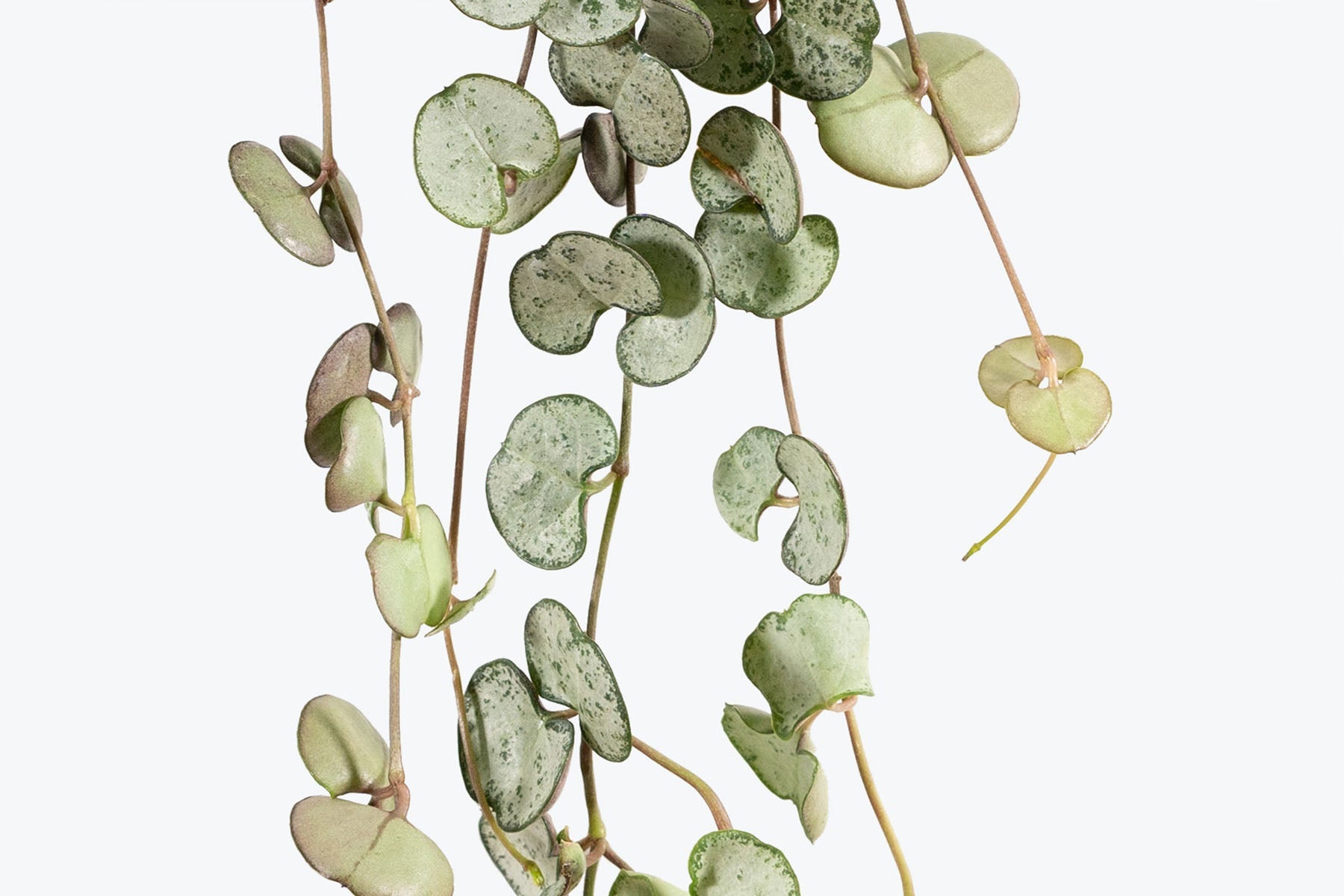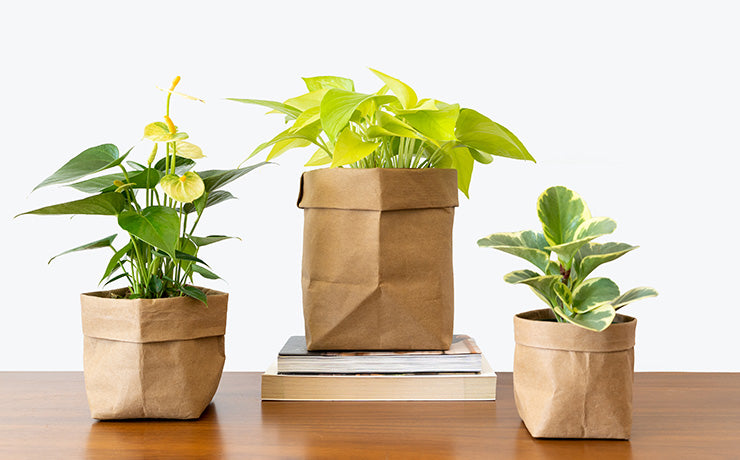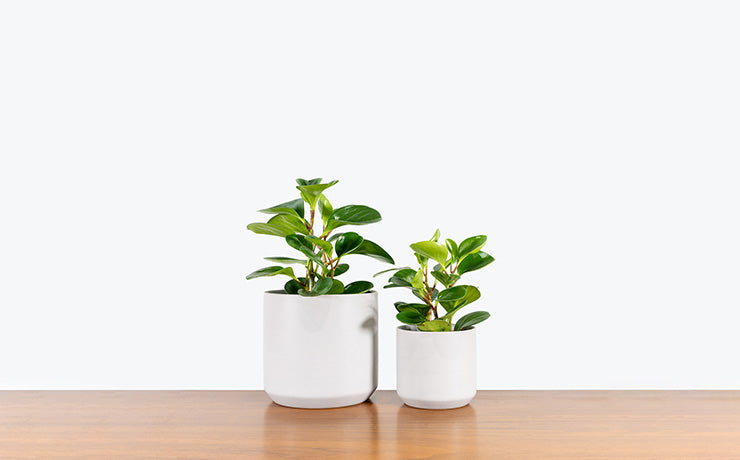
Plant Breakdown: The Difference Between String of Hearts Varieties
With all the "string of things" that exist out there, we wanted to create a breakdown of the different varieties of String of Hearts, specifically, that are available on the market at this time. Although beautiful in a similar way, with their subtle differences it is clear that they are all unique. This guide will help sort out some of the confusion within the Ceropegia genus because this is a genus that you certainly want to have one of each of. A wall of healthy, lush, mature String of Hearts varieties sounds like a great idea to us!
△ 4" String of Hearts
Known under the common name of String of Hearts, Ceropegia woodii varieties are beautiful, trailing houseplants within the Apocynaceae family, native to Africa, southern Asia, and Australia. The delicate, usually heart-shaped foliage and slender vines have given them their other common nicknames, such as Rosary Vine, Sweetheart Vine, Necklace Vine, Lantern Flower, and more. They produce waxy, fountain-like flowers of different forms, depending on the variety, and do so quite easily, as long as they are kept in bright light.
💡
One interesting fact about String of Hearts is that they have roots that swell to create tubers underneath the soil. These tubers store lots of water, as do the semi-succulent leaves that grow on the vines, which is why they are often classified as succulent-like plants, not requiring lots of water to live and grow.
The classic String of Hearts plant, with its mottled green and silver leaves, is incredibly popular, but their stunning foliage makes it obvious as to why. The confusion occurs when other varieties enter the conversation, producing slightly different variegation, different colourings, or different leaf shapes. That's what our guide is for though, so keep reading to find out the key distinctions between the varieties (and one bonus variety) so that you can find out which plants you have and which ones you need to add to your collection!
Ceropegia Woodii
C. woodii is mainly broken down into the following varieties: the original C. woodii, C. woodii variegata, C. woodii 'Silver Glory', and C. woodii 'Durban'. **There are, of course, more varieties of Ceropegia, or even C. woodii, but these are the most readily available on the market today. Even though they are the most common, and often the most confusing since there are some similarities, they are also quite different in their own ways. Let's break down each variety, based on colouring, variegation type, leaf shape, texture, and more:

Ceropegia woodii (String of Hearts)
The original variety, that almost every houseplant enthusiast has had in their collection at one point or another, is the classic String of Hearts. With small, heart-shaped leaves, no two of which are identical, the rich, dark green and silver veining (or mottling) provide a stunning contrast to the burgundy undersides and stems.

Ceropegia woodii variegata (Variegated String of Hearts)
One of the most unique varieties is the Variegated String of Hearts. With foliage similar to the common C. woodii, in shape and feel, this variety has leaves with silver markings along with gorgeous pink and cream variegation. The purple hues of the stems add another beautiful element and, the brighter the light this plant is kept in, the stronger the pink colouring.

Ceropegia woodii 'Silver Glory' (String of Hearts Silver Glory)
Another fantastic plant to add to your collection is the String of Hearts 'Silver Glory'. With similar burgundy stems and thick leaves, this variety actually has apple-shaped (or dare we say butt-shaped) leaves, rather than the classic heart shape. It earned its name from the strong, silver variegation covering the majority of each leaf, with just a thin line of dark green on the edges.

Ceropegia woodii 'Heartless' (String of Spades)
String of Spades, aka C. woodii 'Heartless', 'Durban', or 'Mini Star'. has some similar characteristics to the original String of Hearts, in look and feel, but there are also quite a few differences. The leaves are actually a brighter green, with an even lighter green mottling, and no burgundy undersides but very light pink stems!
Ceropegia Linearis
Bonus entry: Ceropegia linearis. Although not a part of the C. woodii groupings of plants, C. linearis is included here because it is quite easy to find on the market and has the exact same care routine as well as a similar look.

Ceropegia linearis (String of Needles)
The String of Needles is one of those houseplants that is eye-catching due to the unique shape of its delicate leaves. With slender, long, mottled green leaves resembling needles, it is clear what the inspiration for its name was. For these guys, the fuller you keep your plant, the better, as this will encourage a cascade of beautiful needles over time.
Now that we have outlined the most popular or readily available Ceropegia varieties, you can start identifying what you have and figuring out what they need. Below, you can find a quick care guide that goes over the basic care instructions for these stunning houseplants, as they are quite simple to care for and enjoy.
String of Hearts Care Guide
Lighting:
String of Hearts love very bright light, but not prolonged direct sunlight. The brighter the light your plant receives, the more full and compact your plant will remain, with mottled foliage and minimal spacing between the leaves. A nice bright place inside your home would be in an East, West, or South-facing window, either with or without blinds, depending on the sun levels. Remember that plants will grow based on how much light they receive.
Watering:
In the spring/summer months, water your plant fully when the soil is mostly dry, but in the winter months, water your plant when the soil is completely dry. String of Hearts will not tolerate too much water, so avoid keeping the soil overly moist or soggy. All varieties store water in their leaves, a good indicator to watch for is leaves that look a little deflated or wrinkly, which can take up to 4 weeks!
Humidity:
The humidity needs of the Ceropegia genus are quite low, where excess humidity could actually do more damage than good. It would be best to avoid misting them and not putting them in any enclosed terrariums. That being said, they do prefer warmer temperatures over cooler temperatures.
Fertilizing:
When it comes to fertilizing String of Hearts, they are very low maintenance feeders so won't need it very frequently. Once a month, during the growing season of May - August, feed your plant with a diluted liquid fertilizer. In the dormant period of the winter months, hold off on feeding your plant until it begins to actively grow again.
Toxicity:
They are non-toxic to both pets and humans! You can feel safe having these stunners hanging around your home if you have any inquisitive hands and mouths.
Propagating:
If you want a more full and lush plant, you can take cuttings of your plant and re-plant them back into the pot. Just make sure there is a node (where a leaf used to meet the stem) inserted into the soil and then the top of the plant is receiving bright light to encourage rooting. Resting longer vines on top of the soil will also encourage new roots and shoots to form from additional nodes (with leaves left on as they don't have to be buried).
The Ceropegia genus clearly holds plenty of beautiful varieties of strings of things, the most popular of which is the String of Hearts. Besides the classic variety, there are so many interesting variations, with unique colourings and leaf shapes, that are also great additions to any plant collection. We hope this short article clears up any questions you may have had about the differences between these beautiful houseplants. No matter how similar the different varieties look, they all have their own slightly different growth pattern or variegation, so owning one is not owning them all!







